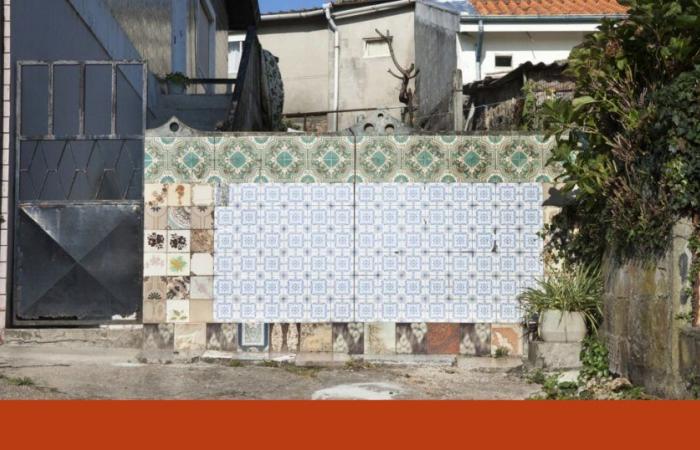
In a city undergoing rapid transformation and contaminated by global and generic languages, what space is left for other imaginaries and individual brands of those who live there? Ana Miriam Rebelo has been thinking about the subject for several years. A photographer with a trained eye for details and delicacies, she was enchanted by a somewhat invisible Porto, ignored in the city’s official communication strategies. And she began to collect “remnants” of this “shadow city” where the construction of public space preserves the marks of citizens.
These could be additions and alterations to houses, street benches, alternative house number identifications, animal houses, mailboxes and fences. Or simply embellishments of places, more or less creative, with tiles, vases, figurines, weather vanes. Ana Miriam’s collection not only aims to “preserve the memory” of these signs, but also “to transport something to the future”. Without romanticization or nostalgia, but encouraging participation in public space.
The matter became a topic of investigation. Soon, Ana Miriam will defend her doctoral thesis in Design at the Faculty of Fine Arts of the University of Porto, with a project financed by FCT and hosted by the Institute for Research in Design Media and Culture (ID+) and the Center for Architecture Studies and Urbanism (CEAU). But from this investigation – Visual and semantic identities of the city of Porto: an investigation of the contributions of informal housing – an exhibition has already appeared. The shadow city and what shines in it – at Mira Fórum until March 30 – is also a proposal for interaction with the city and opened a call for citizen participation, inviting them to observe the city and share their visual records and reflections on the topic for the email [email protected], through Instagram (@imagina_porto) or Facebook. This collection will not stop with the end of the exhibition at Mira, which on the last day projects these images, and the photographs and reflections will continue to be shared on social media. On the Porto Informal page, the researcher also shows her “visual archive under construction”.
Ana Miriam
“Unrepeatable aesthetics”
Citizen representation in public space reflects “the daily presence of residents, their identities, and is also an expression of care”. A “spontaneous” care, with public space and its border with private space, which highlights a “practice of participation in the commons” which, as it exists now, tends towards extinction. “It is important to document them, because they are unrepeatable configurations and aesthetics”, argues Ana Miriam.
From the domestic spaces of Porto – especially in the East of the city, where the case study of her thesis was centered –, Ana Miriam discovered appropriations where the stories of the places also fit, many of them inhabited by people coming from rural geographies for decades (and curiously, in some cases, now places of settlement for immigrant communities). In Noêda, she found a set of vases embellished by a resident over 90 years old. “They used to throw garbage in that place and she found a way to avoid it.” In a neighborhood next to the railway, she met an “exterior decorator” who created a tile panel on a wall. “These are super inspiring processes. Sometimes they resolve things in a more positive way than bans.”
For the researcher, it is important to “find ways to preserve possibilities for spontaneous participation in the production of space”. And none of this has to do with “crystallizing” matter and ways of life, he emphasizes, but with thinking about what, from this past, can and should be carried into the future. For a simple reason: “If the production of space is not participated in, it will be difficult for us to recognize ourselves in the city.”
The “strangeness” in relation to the city, which “changed very quickly” in recent years, is already real in some contexts – either because people are no longer able to live there, as a result of real estate speculation, or because they no longer recognize it. “In Baixa there is a very generic and global language that stifles singularities”, he explains. In a residential context, “regular aesthetics do not inspire intervention” and “an understanding that common spaces should not be used” gained ground.
With ethnographic work, very focused on photography, but also with conversations with residents, Ana Miriam gave shape to the “intuition” that there was a “value” in these representations that “subverts, intentionally or not, more normative ways of being in public space. ” and that offer “aesthetic diversity” to the city. “There is a political dimension to this intervention.”
Ana Miriam
Ana Miriam
Identity vs. representation
Ana Miriam doesn’t like the word “identity”. “It’s a very complicated concept…” The problem originates from Marketing’s adaptation of “place identity”, a concept from environmental psychology related to the ties between people and geographies. “Marketing took over the idea, until we started talking about the identity of the place as a graphic identity”, explains the researcher. “When this takes up so much space, it seems problematic to me, because our relationship with the city is not, first and foremost, commercial. We are citizens and not consumers.”
It can be called,for example, identity to the graphic image created by Porto City Council for the municipality. But it is the “Porto” brand. a representation of the city? “Saying identity leads to naturalizing something that is a construction and that is always political”, she argues. “I prefer to use the word ‘representation’. It seems more honest to me.” For the researcher, the Porto brand. has “a very outward-looking and generic image” – similar, in fact, to images of cities like Prague – which does not reflect representations like the ones she took in photographs. Building a collective representation would, in her opinion, require the integration of this “popular expression in the production of space”.
The richness of cities, says the photographer and researcher, lies in “diversity” – and this is the result of “participation”. “If forms of participation are not reinvented, the production of public space will be dominated by very few agents and this is already happening”, she diagnoses, recalling that public space is a “very important discursive space”. “We are talking about democracy.”
Ana Miriam
The balance is delicate. Ana Miriam recognizes some “valuation” of these spaces “overshadowed by exercises and aesthetics of branding”, using words from his thesis advisor, Heitor Alvelos, from the Faculty of Fine Arts of the University of Porto, who wrote the page sheet for the Mira exhibition. But this tribute leads, in some cases, to a “giant aesthetic transformation”, points out Ana Miriam: “The problem is that they become something completely different.” An example: transforming an island into an AL is valuing, but it is also emptying the initial meaning of that place.
The title of the exhibition – The shadow city and what shines in it – plays with this ambivalence: “It is a shadow city, in the sense of side b, of the city overshadowed by the hypervisibility of the rest. This may have a negative side, of marginalization, but at the same time this invisibility brings advantages.”
Although the demonstrations Miriam found were, in most cases, carried out by an older population, the researcher found a “concern about the possibility of these spaces disappearing” and, here and there, an involvement of younger people. “Urban gardens are a sign of appropriation. The success of Worst Tours [projecto turístico que mostra o lado mais esquecido e desconhecido do Porto] It is also proof that what is different is valued. There are people worried about this.”
During her doctorate process, Ana Miriam Rebelo carried out workshops with students from the faculties of Architecture, Fine Arts and ESAP, with collages from images from their archive. “It was an intuitive and collective construction”, in every way consistent with the objective of its project, driving new representations of the city. This work should lead to another exhibition in partnership with Mira, galleries where the researcher knocked on the door to ask Manuela Matos Monteiro for mediation help with the local population – and where she left with plans for two exhibitions.
Ultimately, concludes the photographer and researcher, everything leads to the concept of the right to the city, coined by Henri Lefebvre in the last century. Not only in terms of housing and centrality, but also in the “right to work”, he summarizes. “The right to feel that we participate in what is also ours. This creates a very different relationship with places.”





